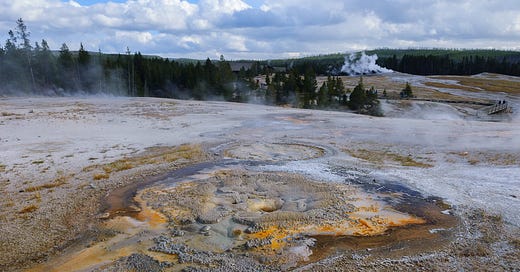Hot springs and CSI
A story of science, serendipity, and what happens when you're free to explore
I posted a thread over on Bluesky yesterday about some fun science history, and it really took off. With my background in science and biology, I thought I’d share the story here along with some photos I took on a photo safari in Yellowstone National Park back in 2007. You may not know the connection between volcanic hot springs in Yellowstone and your favorite crime lab show, but let’s go for a ride!
Back in the late 1960s, a bacteriologist named Thomas Brock at the University of Indiana, Bloomington, received government grants from the National Science Foundation (NSF) and the Atomic Energy Commission to look for bacteria living in extreme environments. This kind of basic science happens all the time at colleges and universities around the world.
They chose to poke around the thermal hot springs of one of America's best-known public lands: Yellowstone National Park. These hot springs are known for being quite nasty; many are hot and even acidic. They’re also quite pretty! You certainly don’t want to bathe in these; they can be toxic to most life.
What Brock and his colleagues discovered was a new species of thermophilic (heat-loving) bacteria that could easily survive at 70°C, even up to 79°C (that's 158-174°F). This was indeed astonishing, because at the time most scientists believed that 55°C (131°F) was the uppermost limit that could support life.
Why? At extreme temperatures, proteins (enzymes) DENATURE and become irreparably damaged by heat. Think of a scrambled egg… you can’t unscramble it, especially after it’s been cooked!
Brock’s team went on to describe the new bacteria species in detail, and gave it the name: Thermus aquaticus, which roughly translates as "Hot Water." A hot-water dweller that can survive in places where most life would boil to death.
Now, surely by now you're probably thinking, "well, that's nice, but who cares about some little bacteria living in a hot spring?”
Well, fast forward to the mid-1970s. Scientists started studying and isolating the enzymes from T. aquaticus, because they were uniquely resistant to heat, even at temperatures of 90°C (194°F).
One of these enzymes was a DNA polymerase; a protein molecule that assembles new DNA from a single (open) strand. You probably recall that DNA is a double-stranded molecule. If you “unzip” it, the internal base pairs separate and are exposed to enzymes for replication. This happens naturally in our own cells, but in the lab you need to heat DNA to get it to unzip, or “denature.” DNA denatures at temperatures around 90°C. In other words, if you heat DNA enough, the two strands separate, but you’ll also destroy any enzymes you wanted to use in your lab experiment.
Enter our newly-discovered heat resistant enzyme: Taq Polymerase, so named for the bacteria it was isolated from: Our new friend, T. aquaticus. Taq polymerase remains stable even at 90°C, so now you can heat up your DNA sample and denature it without killing your crucial enzyme!
Now, toss in some nucleotide bases (you learned these as A/T/C/G), heat the DNA to 90°C to open it up, and then cool it down just enough to let your polymerase work… BOOM! You just replicated a single piece of DNA into two identical copies. Every time you repeat the heating cycle another round of replication happens, and the DNA copies grow exponentially: 2/4/8/16/32/64/128…
This process is the fundamental basis of a technique called Polymerase Chain Reaction, or PCR, and it’s used everywhere now. Every molecular biology lab, from crime labs to to ancestry sites like 23andme relies on this technology, and it would never have been possible without a scientist getting government funding to poke around a hot spring in a US National Park without knowing where it would lead to. So next time you’re watching your favorite crime investigation show, you can think back to the hot springs in Yellowstone National Park.
Photo Details
This is still a photography blog, right? Here’s what gear I used for the photos in this article:
Nikon D2Xs with 17-55mm f/2.8 DX Nikkor lens (FF equivalent of 26-85mm)
Top image: 1/60s f/7.1 ISO 100
Middle image: 1/30s f/11 ISO 100
I used a Gitzo 3-series tripod equipped with a Really Right Stuff BH-55 ball head
I probably used a polarizing filter, but I can’t remember…






